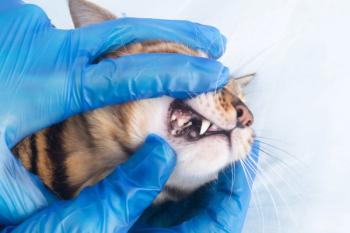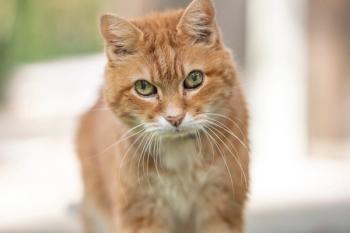
Is "clipnosis" the answer to calming cats in the clinic?
Using two-inch standard binder clips to induce pressure on the neck, just behind the ear, the researchers obtained positive results.
Finding a convenient and safe way to calm and immobilize cats for minor veterinary procedures without the use of pharmaceuticals sounds like magic. A group of researchers at The Ohio State University in the Department of Veterinary Clinical Sciences and at a veterinary clinic in Sainte-Foy-Lès-Lyon, France, studied a simple way to do just that.
Veterinarians and pet owners have long known that holding cats by their scruff provides adequate restraint for nail trimming or administering injections. The application of neck clips, similar to "scruffing," to induce immobility has been studied in other species with positive results, and previous reports have documented successful immobilization of cats by placing clips along the dorsal midline. However, placing clips along a cat's neck has not been widely recognized as a safe and practical method of restraint.
Using two-inch standard binder clips to induce pressure on the neck, just behind the ear, the researchers obtained positive results.
They studied 13 healthy cats and 18 cats with idiopathic cystitis. The pressure applied by the clips was measured and found to be within the range of systolic blood pressure (140 to 160 mmHg). Each cat was ranked based on its responses to the placement of one or two clips, or pinch-induced behavioral inhibition (PIBI), a term that describes the method as well as the response. PIBI is also casually called "clipnosis."
After the initial experience, the cats were clipped again one, two, and three months later. Additionally, one-third of the cats in each group were examined before and during the procedure by a board-certified veterinary neurologist. Their mentation, menace response, facial sensation, and leg support capabilities were evaluated. Four months after the initial clipping, the cats were ranked based on their response to scruffing to learn if this might be a good indicator of PIBI response.
The positive response to the clipping was almost identical to that seen in kittens picked up by the skin of their neck by their mother. The level of immobilization and relaxation varied among individuals, and some of the cats even began to purr; 92% of the healthy cats and 100% of the idiopathic cystitis cats responded positively (see photo). Additionally, most of the cats showed an increased tolerance for the procedure after repeated experiences. A positive scruffing score appeared to be predictive of a positive PIBI response, giving clinicians an easy way to evaluate patients before using this procedure.
Clips have been applied to this cat's neck as a method of restraint. The cat, shown here in right lateral recumbency, is quietly kneading with its left forepaw. (Photo courtesy of C.A. Tony Buffington.)
The neurologic evaluations revealed that mentation was significantly decreased by PIBI, and all cats exhibited miosis. The cats did not exhibit signs of pain such as tachypnea, tachycardia, or mydriasis. Moreover, no significant changes in heart rate, blood pressure, or temperature were observed in 15 of the cats that had implanted telemetry devices. The researchers concluded that PIBI is not a fear or pain response.
The response seen in these cats was impressive, and reflected calm, content, and less fearful patients. No cats exhibited physical changes or behavior suggestive of pain or stress. The researchers caution that they have observed that the procedure is not effective when cats are already excited or agitated, and they recommend using clipnosis as a first choice on already calm, quiet patients before beginning procedures. While this study did not look at the analgesic effects of PIBI, it does give clinicians a new restraint option for such minor procedures as obtaining blood samples, clipping nails, or performing a complete physical examination.
Editor's note: OurPet's Co. has been licensed to manufacture and market a specially designed clipnosis clip (seen on the cat in the photo) worldwide;
Pozza ME, Stella JL, Chappuis-Gagnon A, et al. Pinch-induced behavioral inhibition ('clipnosis') in domestic cats. J Feline Med Surg 2008;10:82-87.
Newsletter
From exam room tips to practice management insights, get trusted veterinary news delivered straight to your inbox—subscribe to dvm360.






